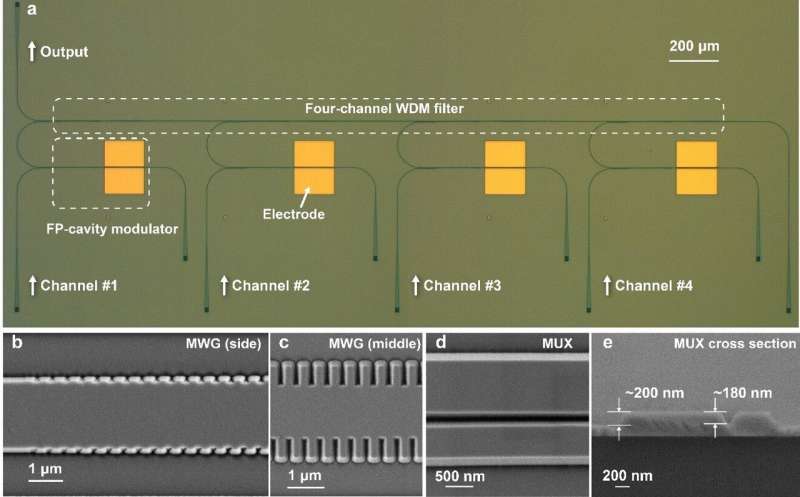This article has been reviewed according to Science X's editorial process and policies. Editors have highlighted the following attributes while ensuring the content's credibility:
fact-checked
proofread
New photonic chips for high-capacity data transmissions

With the growth in artificial intelligence (AI), 5G systems, cloud computation, and the Internet of Things, transmitters with extremely high capacities are required for data communication. Ultrafast optical modulation is an essential technology for high-capacity transmitters. High-speed optical modulators have attracted considerable interest. Significant progress has been achieved using different mechanisms in various material systems.
In a new paper published in Light: Advanced Manufacturing, a team of scientists led by Daoxin Dai from Zhejiang University developed a compact lithium-niobate-on-insulator (LNOI) photonic chip.
Optical modulators on a lithium-niobate-on-insulator (LNOI) platform have exhibited great potential. This arises from a linear electro-optic (EO) effect, low excess loss, and high stability. LNOI EO modulators based on Mach-Zehnder interferometers and microresonators have performed excellently. The length of the phase-shifting arms is typically several millimeters, or even centimeters, to realize a low voltage. Traveling-wave electrodes have been introduced, along with high-speed MZMs. Due to their large footprint, the arraying LNOI MZMs is inconvenient for high-capacity multiplexed systems with multiple channels.
Alternatively, the resonator-based modulators of LNOI can be compact, which may reduce power consumption. Therefore, resonator-based LNOI modulators have attracted significant attention in recent years. The research team has successfully demonstrated high-speed LNOI modulators based on a specific 2 × 2 Fabry-Perot (FP) cavity. It enables an ultra-high 3-dB bandwidth beyond 110 GHz and data capacity up to 140 Gbps. The footprint of the modulation section is much smaller than that of the reported LNOI ring resonator modulators. It is very attractive for arraying wavelength-division multiplexing (WDM) systems.
Meanwhile, advanced multiplexing techniques have been widely studied to expand link capacity by transmitting data through multiple channels in parallel. WDM has been successfully applied in which multiple wavelength channels are introduced. In recent years, various waveguide structures have been developed to realize WDM filters with excellent performance.
Great efforts have been made and impressive progress has been achieved utilizing smart designs without waveguide bends in key regions. A four-channel coarse WDM transmitter chip on LNOI has been demonstrated using a multiplexer, including an angled multimode interferometer. The research team proposed and developed a promising LNOI photonic filter based on a straight multimode waveguide grating (MWG). It enables a box-like spectral response whose central wavelength and bandwidth can be designed flexibly. A four-channel WDM filter with box-like responses was established using cascaded LNOI MWGs for the first time.
Photonic waveguides and circuits of large scale present increased manufacturing requirements. High-quality fabrication is critical for achieving low-loss and low-phase error light propagation in optical waveguides. Several typical fabrication technologies have been established for LNOI photonic waveguides. Dry-etching is preferred because of its process compatibility and fabrication repeatability. Inductively coupled plasma (ICP) etching with Ar gas is one of the most common methods for fabricating LNOI photonic waveguides and devices.
The chip features transport cascading and channel uniformity. Experimentally, the proposed chip enables high-capacity data transmission of 320 Gbps OOK signals, and 400 Gbps PAM4 signals with a low power consumption of 11.9 fJ/bit. This indicates enormous potential for the large-scale photonic integration of LN and the bright prospect of LNOI regarding its widespread use in integrated photonic devices.
The present photonic chip with an ultracompact footprint can be scaled for more channels and thus shows great potential for further realization of ultrahigh-capacity and energy-efficient WDM transmitters on LNOI in the future. Introducing SiO2, amorphous-Si, or Cr hard masks can improve the fabrication process. With an improved etching process, the propagation loss (mainly originating from the scattering loss at the sidewalls) can be reduced to a wafer scale. It will support the development of high-performance LNOI photonic integrated circuits and satisfy the growing demands for various applications.
More information: Hongxuan Liu et al, Ultra-compact lithium niobate photonic chip for high-capacity and energy-efficient wavelength-division-multiplexing transmitters, Light: Advanced Manufacturing (2023). DOI: 10.37188/lam.2023.013
Provided by TranSpread





















